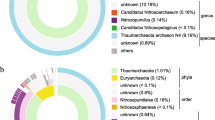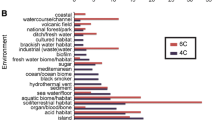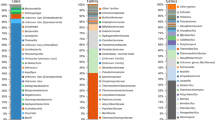Abstract
We pyrosequenced the bulk DNA extracted from microorganisms that passed through 0.2-μm-pore-size filters and trapped by 0.1-μm-pore-size filters in the hydrothermal fluid of the Mariana Trough. Using the 454-FLX sequencer, we generated 202,648 sequences with an average length of 173.8 bases. Functional profiles were assigned by the SEED Annotation Engine. In the metagenome of the 0.2-μm-passable microorganisms, genes related to membrane function, including potassium homeostasis classified as membrane transport, and multidrug-resistance efflux pumps classified as virulence, were dominant. There was a higher proportion of genes pertinent to the subsystem of membrane transport in our metagenomic library than in other oceanic and hydrothermal vent metagenomes. Genes associated with a RND-type efflux transporter for exogenous substances were specifically identified in the present study. After a comparative analysis with the genome of the known ultramicrobacterium Sphingopyxis alaskensis RB2256, we discovered 1,542 cases of significant hits (E < 1 × 10−2) in our metagenome, and 1,172 of those were related to the DNA repair protein RadA. In this way, the microbial functional profile of 0.2-μm-passable fraction in the present study differs from oceanic metagenomes in the 0.2-μm-trapped fractions and hydrothermal vent metagenomes reported in previous research.
Similar content being viewed by others
References
Abulencia CB, Wyborski DL, Garcia JA, Podar M, Chen W, Chang SH, Chang HW, Watson D, Brodie EL, Hazen TC et al (2006) Environmental whole-genome amplification to access microbial populations in contaminated sediments. Appl Environ Microbiol 72:3291–3301
Beam CE, Saveson CJ, Lovett ST (2002) Role for radA/sms in recombination intermediate processing in Escherichia coli. J Bacteriol 184:6836–6844
Beja O, Suzuki MT, Koonin EV, Aravind L, Hadd A, Nguyen LP, Villacorta R, Amjadi M, Garrigues C, Jovanovich SB et al (2000) Construction and analysis of bacterial artificial chromosome libraries from a marine microbial assemblage. Environ Microbiol 2:516–529
Boenigk J, Stadler P, Wiedlroither A, Hahn MW (2004) Strain-specific differences in the grazing sensitivities of closely related ultramicrobacteria affiliated with the Polynucleobacter cluster. Appl Environ Microbiol 70:5787–5793
Breitbart M, Salamon P, Andresen B, Mahaffy JM, Segall AM, Mead D, Azam F, Rohwer F (2002) Genomic analysis of uncultured marine viral communities. Proc Natl Acad Sci USA 99:14250–14255
Cole JR, Chai B, Farris RJ, Wang Q, Kulam SA et al (2005) The Ribosomal Database Project (RDP-II): sequences and tools for high-throughput rRNA analysis. Nucleic Acids Res 33:D294–296
DeLong EF, Preston CM, Mincer T, Rich V, Hallam SJ, Frigaard NU, Martinez A, Sullivan MB, Edwards R, Brito BR et al (2006) Community genomics among stratified microbial assemblages in the ocean’s interior. Science 311:496–503
Edwards RA, Rodriguez-Brito B, Wegley L, Haynes M, Breitbart M, Peterson DM, Saar MO, Alexander S, ECJr A, Rohwer F (2006) Using pyrosequencing to shed light on deep mine microbial ecology. BMC Genomics 7:57
Elsaied HE, Sato M, Naganuma T (2001) Viable cytophaga-like bacterium in the 0.2 microm-filtrate seawater. Syst Appl Microbiol 24:618–622
Erwin DP, Erickson IK, Delwiche ME, Colwell FS, Strap JL, Crawford RL (2005) Diversity of oxygenase genes from methane- and ammonia-oxidizing bacteria in the Eastern Snake River Plain aquifer. Appl Environ Microbiol 71:2016–2025
Gamo T (1995) Wide variation of chemical characteristics of submarine hydrothermal fluids due to secondary modification processes after high temperature water–rock interaction: a review. In: Sakai H, Nozaki Y (eds) Biogeochemical processes and ocean flux in the Western Pacific. Terra Scientific Publishing Co (TERRAPUB), Tokyo, pp 425–451
Geissinger O, Herlemann DP, Morschel E, Maier UG, Brune A (2009) The ultramicrobacterium “Elusimicrobium minutum” gen. nov., sp. nov., the first cultivated representative of the termite group 1 phylum. Appl Environ Microbiol 75:2831–2840
Giovannoni SJ, Hayakawa DH, Tripp HJ, Stingl U, Givan SA et al (2008) The small genome of an abundant coastal ocean methylotroph. Environ Microbiol 10:1771–1782
Gomez-Alvarez V, Teal TK, Schmidt TM (2009) Systematic artifacts in metagenomes from complex microbial communities. Isme J 3:1314–1317
Hahn MW (2003) Isolation of strains belonging to the cosmopolitan Polynucleobacter necessarius cluster from freshwater habitats located in three climatic zones. Appl Environ Microbiol 69:5248–5254
Hahn MW (2004) Broad diversity of viable bacteria in ‘sterile’ (0.2 microm) filtered water. Res Microbiol 155:688–691
Hahn MW, Lunsdorf H, Wu Q, Schauer M, Hofle MG, Boenigk J, Stadler P (2003) Isolation of novel ultramicrobacteria classified as actinobacteria from five freshwater habitats in Europe and Asia. Appl Environ Microbiol 69:1442–1451
Hahn MW, Stadler P, Wu QL, Pockl M (2004) The filtration-acclimatization method for isolation of an important fraction of the not readily cultivable bacteria. J Microbiol Methods 57:379–390
Hallam SJ, Putnam N, Preston CM, Detter JC, Rokhsar D, Richardson PM, DeLong EF (2004) Reverse methanogenesis: testing the hypothesis with environmental genomics. Science 305:1457–1462
Haller CM, Rolleke S, Vybiral D, Witte A, Velimirov B (1999) Investigation of 0.2 μm filterable bacteria from the Western Mediterranean Sea using a molecular approach: dominance of potential starvation forms. FEMS Microbiol Ecol 31:153–161
Holden JF, Adams MW (2003) Microbe–metal interactions in marine hydrothermal environments. Curr Opin Chem Biol 7:160–165
Hugenholtz P, Tyson GW (2008) Microbiology: metagenomics. Nature 455:481–483
Ishibashi J, Yamanaka T, Kimura H, Hirota A, Toki T, Tsunogai U, Gamo T, Utsumi M, Roe K, Miyabe S, Okamura K (2004) Geochemistry of hydrothermal fluids from south Mariana backarc spreading center. EOS Trans AGU, 85(49), Fall Meet Suppl, Abstract V44A-05.
Jannasch HW (1995) Microbial interactions with hydrothermal fluids. In: Humphris SE, Zierenberg RA, Mullineaux LS, Thomson RE (eds) Seafloor hydrothermal systems. American Geophysical, Union Geophysical Monograph 91, Washington, pp 273–296
Joux F, Jeffrey WH, Lebaron P, Mitchell DL (1999) Marine bacterial isolates display diverse responses to UV-B radiation. Appl Environ Microbiol 65:3820–3827
Kieft TL (2000) Size matters: dwarf cells in soil and subsurface terrestrial environments. In: Colwell RR, Grimes DJ (eds) Non-culturable microorganisms in the environment. American Society for Microbiology, Washington, pp 19–46
Maniloff J (1997) Nannobacteria: size limits and evidence. Science 276:1776, author reply 1777
Martín-Cuadrado AB, Lopez-Garcia P, Alba JC, Moreira D, Monticelli L et al (2007) Metagenomics of the deep mediterranean, a warm bathypelagic habitat. PLoS ONE 2:e914
Matallana-Surget S, Joux F, Raftery MJ, Cavicchioli R (2009) The response of the marine bacterium Sphingopyxis alaskensis to solar radiation assessed by quantitative proteomics. Environ Microbiol 11:2660–2675
Meyer F, Paarmann D, D’Souza M, Olson R, Glass EM, Kubal M, Paczian T, Rodriguez A, Stevens R, Wilke A et al (2008) The metagenomics RAST server—a public resource for the automatic phylogenetic and functional analysis of metagenomes. BMC Bioinformatics 9:386
Miyoshi T, Iwatsuki T, Naganuma T (2005) Phylogenetic characterization of 16S rRNA gene clones from deep-groundwater microorganisms that pass through 0.2-micrometer-pore-size filters. Appl Environ Microbiol 71:1084–1088
Naganuma T, Miyoshi T, Kimura H (2007) Phylotype diversity of deep-sea hydrothermal vent prokaryotes trapped by 0.2- and 0.1-microm-pore-size filters. Extremophiles 11:637–646
Novitsky JA, Morita RY (1976) Morphological characterization of small cells resulting from nutrient starvation of a psychrophilic marine vibrio. Appl Environ Microbiol 32:617–622
Overbeek R, Begley T, Butler RM, Choudhuri JV, Chuang HY, Cohoon M, de Crecy-Lagard V, Diaz N, Disz T, Edwards R et al (2005) The subsystems approach to genome annotation and its use in the project to annotate 1000 genomes. Nucleic Acids Res 33:5691–5702
Pruesse E, Quast C, Knittel K, Fuchs BM, Ludwig W et al (2007) SILVA: a comprehensive online resource for quality checked and aligned ribosomal RNA sequence data compatible with ARB. Nucleic Acids Res 35:7188–7196
Raghunathan A, Ferguson HR Jr, Bornarth CJ, Song W, Driscoll M, Lasken RS (2005) Genomic DNA amplification from a single bacterium. Appl Environ Microbiol 71:3342–3347
Rappe MS, Connon SA, Vergin KL, Giovannoni SJ (2002) Cultivation of the ubiquitous SAR11 marine bacterioplankton clade. Nature 418:630–633
Rusch DB, Halpern AL, Sutton G, Heidelberg KB, Williamson S, Yooseph S, Wu DY, Eisen JA, Hoffman JM, Remington K et al (2007) The sorcerer II global ocean sampling expedition: Northwest Atlantic through Eastern Tropical Pacific. Plos Biology 5:398–431
Schut F, Devries EJ, Gottschal JC, Robertson BR, Harder W et al (1993) Isolation of typical marine bacteria by dilution culture: growth, maintenance, and characteristics of isolates under laboratory conditions. Appl Environ Microbiol 59:2150–2160
Thurber RV, Willner-Hall D, Rodriguez-Mueller B, Desnues C, Edwards RA, Angly F, Dinsdale E, Kelly L, Rohwer F (2009) Metagenomic analysis of stressed coral holobionts. Environ Microbiol 11:2148–2163
Torrella F, Morita RY (1981) Microcultural study of bacterial size changes and microcolony and ultramicrocolony formation by heterotrophic bacteria in seawater. Appl Environ Microbiol 41:518–527
Tringe SG, von Mering C, Kobayashi A, Salamov AA, Chen K, Chang HW, Podar M, Short JM, Mathur EJ, Detter JC et al (2005) Comparative metagenomics of microbial communities. Science 308:554–557
Velimirov B (2001) Nanobacteria, ultramicrobacteria and starvation forms: a search for the smallest metabolizing bacterium. Microbes Environ 16:67–77
Venter JC, Remington K, Heidelberg JF, Halpern AL, Rusch D, Eisen JA, Wu D, Paulsen I, Nelson KE, Nelson W et al (2004) Environmental genome shotgun sequencing of the Sargasso Sea. Science 304:66–74
Vybiral D, Denner EB, Haller CM, Busse HJ, Witte A, Hofle MG, Velimirov B (1999) Polyphasic classification of 0.2 microm filterable bacteria from the western Mediterranean Sea. Syst Appl Microbiol 22:635–646
Walderhaug MO, Polarek JW, Voelkner P, Daniel JM, Hesse JE et al (1992) Kdpd and Kdpe, proteins that control expression of the kdpABC Operon, are members of the two-component sensor-effector class of regulators. J Bacteriol 174:2152–2159
Wang Y, Hammes F, Boon N, Egli T (2007) Quantification of the filterability of freshwater bacteria through 0.45, 0.22, and 0.1 microm pore size filters and shape-dependent enrichment of filterable bacterial communities. Environ Sci Technol 41:7080–7086
Wegley L, Edwards R, Rodriguez-Brito B, Liu H, Rohwer F (2007) Metagenomic analysis of the microbial community associated with the coral Porites astreoides. Environ Microbiol 9:2707–2719
Yokouchi H, Fukuoka Y, Mukoyama D, Calugay R, Takeyama H, Matsunaga T (2006) Whole-metagenome amplification of a microbial community associated with scleractinian coral by multiple displacement amplification using phi29 polymerase. Environ Microbiol 8:1155–1163
Zhang K, Martiny AC, Reppas NB, Barry KW, Malek J, Chisholm SW, Church GM (2006) Sequencing genomes from single cells by polymerase cloning. Nat Biotechnol 24:680–686
Acknowledgment
The authors are obliged to Dr. Motoo Utusmi for cruise opportunities and to the crews and operation teams of RV Yokosuka and DSV Shinkai 6500, Japan Agency for Marine-Earth Science and Technology, for sample collection and onboard assistance. We are very much obliged to Dr. Ryo Kaneko, who filtered deep-sea hydrothermal fluid onboard the ship. This work was supported by the Special Coordination Fund “Archaean Park Project” from the Ministry of Education, Culture, Sports, Science and Technology (MEXT) of Japan; the Fund “Construct the Genetic Resource Library of Unidentified Microbes Based on Genome Information” from the New Energy and Industrial Technology Development Organization, Japan; and Grants-in-Aid for Scientific Research (17657032) from the Japan Society for the Promotion of Science.
Author information
Authors and Affiliations
Corresponding author
Rights and permissions
About this article
Cite this article
Nakai, R., Abe, T., Takeyama, H. et al. Metagenomic Analysis of 0.2-μm-Passable Microorganisms in Deep-Sea Hydrothermal Fluid. Mar Biotechnol 13, 900–908 (2011). https://doi.org/10.1007/s10126-010-9351-6
Received:
Accepted:
Published:
Issue Date:
DOI: https://doi.org/10.1007/s10126-010-9351-6




